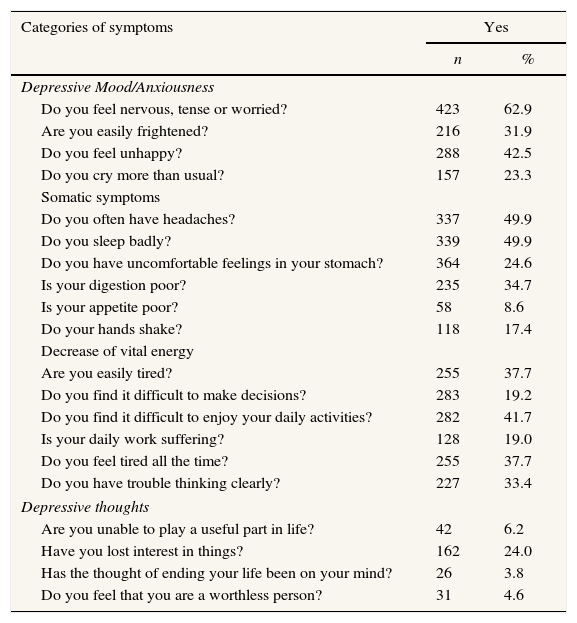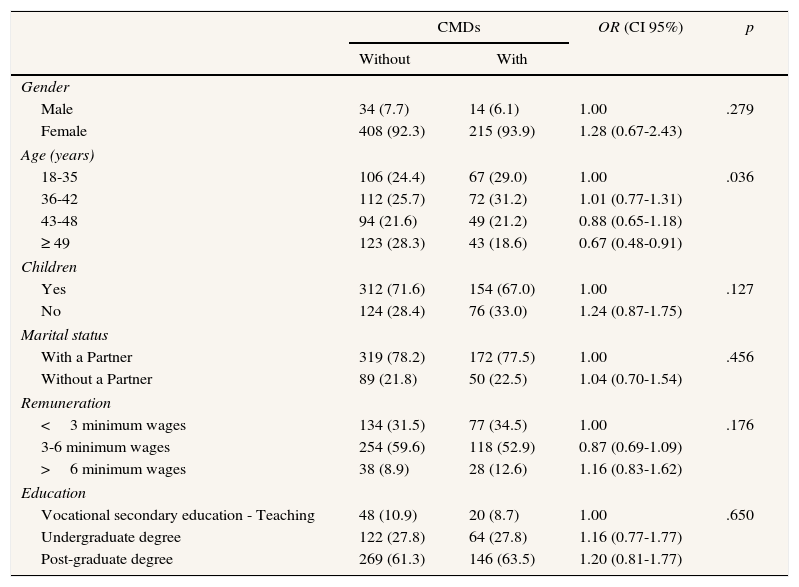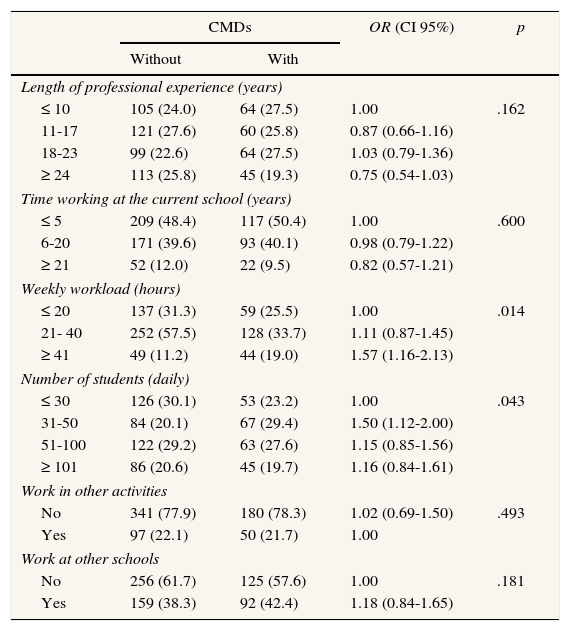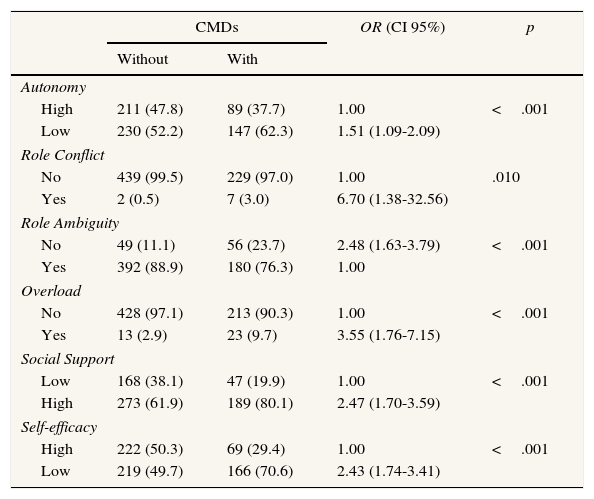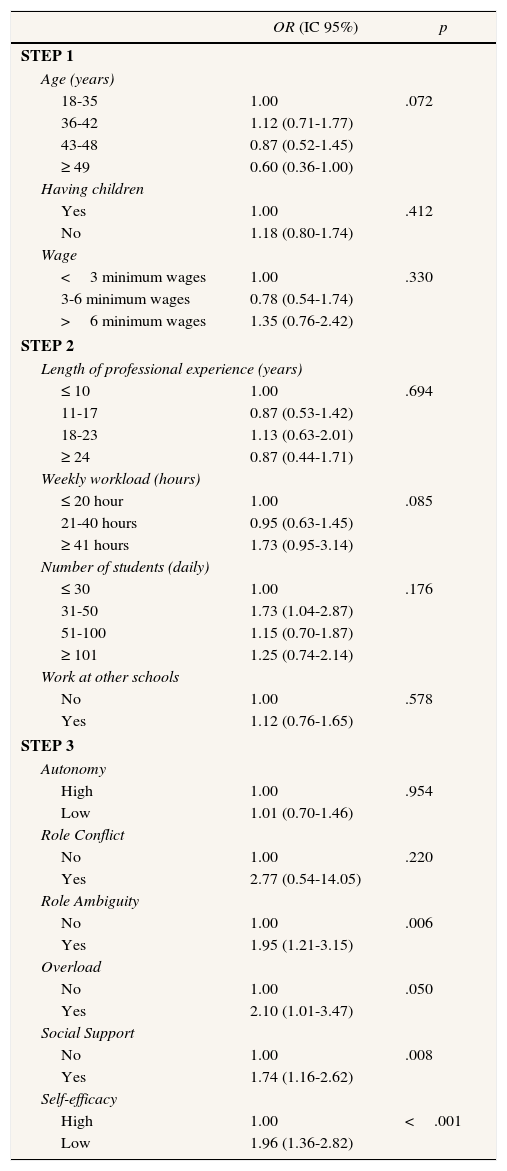This study aimed at identifying the prevalence of Common Mental Disorders (CMDs) in teachers and at analyzing associations between sociodemographic, occupational, and psychosocial factors and CMDs. This was a cross-sectional study with a random sample of 679 teachers, distributed in 37 elementary schools located in a city in the metropolitan area of Porto Alegre (in the state of Rio Grande do Sul, Brazil). The instruments used were the Self-Reporting Questionnaire (SRQ-20); the Battery of Psychosocial Risk Assessment to evaluate role ambiguity, social support, self-efficacy, autonomy, interpersonal conflicts, role conflict, and overload; and a questionnaire to assess sociodemographic and occupational variables. Results showed a 29.7% prevalence of CMDs. Three-stage hierarchical logistic regression was performed. Having role ambiguity, overload, low level of social support, and low perceived self-efficacy were associated with CMDs. Greater attention should be given to psychosocial threats in the school context, since these kinds of variables were associated with CMDs in teachers.
Este estudio tuvo como objetivo identificar la prevalencia de trastornos mentales comunes (TMC) en profesores y analizar las asociaciones entre factores sociodemográficos, ocupacionales y psicosociales y TMC. Fue realizado un estudio transversal con una muestra aleatoria de 679 profesores distribuidos en 37 escuelas de enseñanza primaria localizadas en una ciudad de la región metropolitana de Porto Alegre (Estado de Rio Grande do Sul, Brasil). Los instrumentos utilizados fueron el Self-Reporting Questionnaire (SRQ-20), la Battery of Psychosocial Risk Assessment para evaluar ambigüedad de rol, apoyo social, auto-eficacia, autonomía, conflictos interpersonales, conflictos de rol y sobrecarga y un cuestionario para evaluar variables sociodemográficas y ocupacionales. Los resultados demostraran una prevalencia de TMC de 29.7%. Fue realizado un análisis de regresión logística. Ambigüedad, sobrecarga, bajo nivel de apoyo social y baja percepción de auto-eficacia se asociaron a los TMC. Una mayor atención debe prestarse a las amenazas presentes en el contexto escolar una vez que esa clase de variables se asociaron a los TMC en profesores.
Common Mental Disorders (CMDs) are a group of distress states manifesting with anxiety, depressive, and unexplained somatic symptoms (Goldberg & Huxley, 1992). Mental disorders are a major source of disability, accounting for approximately 12% of the global burden of diseases (Vos et al., 2012). A systematic review and meta-analysis performed by Steel et al. (2014), evaluating the period from 1980 to 2013, found that 29.2% (25.9-32.6%) of the respondents were identified as having experienced a common mental disorder at some time during their lifetimes. Common mental disorders are highly prevalent globally, affecting people across all regions of the world.
From a public health perspective, depression and anxiety disorders are the most important among these disorders, due to their prevalence in the general population. Although CMDs are characterized as types of psychic suffering, they are regarded as having a non-psychotic nature and do not constitute a diagnostic category (Goldberg & Huxley, 1992). Even though some investigations reveal that CMDs represent between 20% and 40% of primary care consultations (Bhui, Stansfeld, McKenzie, Karlsen, & Scott Weich, 2001; Goldberg & Huxley, 1992), they are generally not the main reason for seeking medical attention (Risal, 2011).
According to the World Health Organization, one in every four people develops one or more mental disorders at some stage in life (WHO, 2001). Studies conducted among the Western population have pointed out a variation of prevalence from 7% to 26% for CMDs (Lopes, Faerstein, & Chor, 2003). A systematic review of the literature of Brazilian studies developed from 1997 to 2009, held by Santos and Siqueira (2010), identified a variation between 20% and 56%, depending on the population under investigation.
Environmental factors can have direct effects on these processes (Goldberg & Huxley, 1992). In Brazil there is a variety of factors that contribute to the high prevalence of stressful life events and of mental disorders in the population, such as accelerated processes of urbanization and industrialization, unequal access to health care, inadequate living conditions, income inequality, unemployment, high violence, and crime rates (Lopes et al., 2003).
In Brazil, in 2011, according to data from the Ministério da Previdência Social do Brasil - MPS [Ministry of Social Welfare] (2011), mental and behavioral disorders, listed in chapter V of the International Classification of Diseases (ICD-10), were the third cause for the granting of disability pensions due to incapacity to work. These circumstances tend to increase.
Although they do not have an effect on workers’ survival rates, they may keep them from their activities (Porto et al., 2006). CMDs have been one of the major causes of long-term absences from work (Stansfeld, North, White, & Marmot, 1995) and have great socioeconomic impact, mainly because of lost workdays (Rai, Skapinakis, Wiles, Lewis, & Araya, 2010), amount of disability benefits (Mykletun et al., 2006), and increase in the demand for health services (Broadhead, Blazer, George, & Tse, 1990; Goldberg & Huxley, 1992). Workers with a previous episode of absence due to a CMD are at greater risk of absence due to recurrent illness with common mental disorders in a period of three years (Koopmans et al., 2011).
A meta-analysis of the literature performed by Stansfeld and Candy (2006) identified consistent evidence that the combination of high demand and low decision-making power and of high effort and low rewards are potential risk factors for common mental disorders. In another review of literature, developed by Sanderson and Andrews (2006), one of the results was that workers exposed to adverse psychosocial environments have increased risk of developing CMDs.
Brazilian studies with teachers of private schools found prevalence proportions of CMDs between 20.1% (Araújo et al., 2003) and 41.5% (Delcor et al., 2004). In public education the prevalence was 50.3% (Gasparini, Barreto, & Assunção, 2006). In Germany, a study with teachers identified that 29.8% of the sample had significant mental health problems (Bauer et al., 2007).
In teaching, the consequences of new requirements in the process of school and teaching work are the intensification of work in at least two aspects: intensification due to the expansion of professional demands in teachers’ lives, driven from an administrative and bureaucratic perspective, and self-intensification due to the exploitation of the teachers’ sense of professionalism and their self-images based on the care and attention that historically characterize childhood education (García & Anadon, 2009). The anachronism present on the public educational system, which combines students of the 21st century, schools with structures of the 19th century, and teachers who graduated in the 20th century, have been producing direct effects in the implementation of activities, which affect the professionals’ health (Leão, Oliveira, & Aparecida, 2012).
A study developed by Juncá, Cordeiro, Moraes, Pessanha, and Oliveira (2010), which aimed at developing a profile of the teachers and of the activities in which they were involved, analyzing the relation between their occupation and health conditions, identified that 76.4% of the interviewees thought that the practice of teaching could compromise the professionals’ health. Their main complaints regarding health were headaches and migraines, depression, stress, nervousness, irritability and mood swings, insomnia, discouragement and lack of motivation to work, mental fatigue, forgetfulness, and difficulty to concentrate.
The health of the workforce is inextricably linked to its productivity and to the health of the nation's economy. It also shows that employers increasingly recognize this link and are interested in improving workers’ health by expanding workforce health protection and health promotion programs (Hymel et al., 2011). Therefore, employers, government bodies, and policy makers are interested in reducing the incidence and prevalence of mental health problems at work.
Thus, numerous studies were conducted with the intention of identifying work factors that increase employees’ risk of developing mental health problems (Hilton & Whiteford, 2010). And, in this perspective, the present study, which has an observational epidemiological cross-sectional delineation, aims at identifying the prevalence of CMDs in teachers and at verifying the existence of associations between sociodemographic, occupational and psychosocial variables.
MethodParticipantsThis cross-sectional study was conducted with a calculated random sample of the population of 1,250 teachers distributed in all 37 elementary schools located in a large city in the metropolitan area of Porto Alegre (in the state of Rio Grande do Sul, Brazil). The parameters for sample size calculation were the 50.3% prevalence (Gasparini et al., 2006), 5% error, 80% effect power, and 20% potential losses. The final sample consisted of 713 teachers. The collected sample consisted of 679 teachers, with a loss of 34 participants.
Most participants were women (91.8%), with a partner (60.8%) and children (68.6%). Their average age was 42 years (SD=9) and their salaries were higher than three minimum wages, a reference in Brazil (51.2%). Most participants have a post-graduate degree (61.8%). The majority of the professionals work exclusively at the school under investigation (74.2%). Participants have an average of 17 years of professional experience (range=1-47, SD=8.9, Mode=15) and 8.8 years of professional experience at the school (SD=7.2). The workload varies between 16 and 57hours a week, with an average of 34hours a week (SD=11.6, Mode=40). The amount of students they work with per day ranges between 7 and 500, with an average of 77 students per day (SD=74, Mode=60).
InstrumentsData were collected using a questionnaire that was specifically designed to investigate some sociodemographic factors (gender, age, marital status, children) and working variables (education, weekly workload at the institution, wages, time working at the institution, work in other activities, jobs at other schools). Additionally, the following self-report instruments were used:
Self-Reporting Questionnaire (SRQ-20). This scale has been designed to assess the presence of common mental disorders. It has been validated for use in Brazil by Mari and Williams (1986). It comprises 20 yes/no questions about physical and psychological symptoms, for the detection of minor psychiatric disorders (anxiety, depression, psychosomatic reactions, irritability, and mental fatigue). Each affirmative answer corresponds to a score of 1 in the final score (sum of all scores). The scores obtained indicate the probability of the presence of non-psychotic disorders, and may range from 0 (in probability) to 20 (extreme probability). The instrument has a Cronbach's alpha of .86 and a cutoff point of 7/8, regardless of gender (Gonçalves, Stein, & Kapczinski, 2008). In the current sample the Cronbach's alpha was .88.
Battery of Psychosocial Risk Assessment (Unidad de Investigación Psicosocial de la Conducta Organizacional- UNIPSICO), by Gil-Monte (2005), evaluating: Role Ambiguity (5 items, α=.78), Social Support (5 items, α=.75), Self-efficacy (8 items, α=.79), Autonomy (5 items, α=.76), Role Conflict (5 items, α=.76), and Overload (6 items, α=.79). All items are assessed on a five-point Likert scale of frequency, ranging from 0 (never) to 4 (every day). The Cronbach's alpha obtained in the present study was: Role Ambiguity (α=.77), Social Support (α=.84), Self-efficacy (α=.89), Autonomy (α=.76), Role Conflict (α=.76), and Overload (α=.71).
ProceduresFirst, we contacted the City's Educational Department and presented the object of the study in order to obtain authorization and support to implement the instruments. Teachers answered the instruments at their workplace. The instruments were collected after they were filled out. The application occurred from September to November 2013. The first author of this study collected the data. Research ethics committees of the Pontifical Catholic University of Rio Grande do Sul/Brazil (PUCRS) approved the study.
The statistical software PASW, version 17 (SPSS/PASW, Inc., Chicago, IL), was applied to conduct the data analysis. Descriptive statistics were used to calculate frequencies, mean scores, and standard deviations. The data analysis began with bivariate analyses between the outcome and the study factors. The multivariate logistic regression included the variables that originally presented p-values <.20. The logistic regression was performed according to a three-stage hierarchical model. The demographic variables were introduced in the first stage, and only those with p <.10 were kept in the model. The working variables were introduced in the second stage, using the same criterion to keep them in the regression. The third stage included psychosocial variables. Significant associations were defined as those with p-values <.05 in the stage in which they were introduced in the model.
ResultsTable 1 shows the results of the descriptive analyses according to categories of symptoms for items of the Self-Reporting Questionnaire (SRQ-20). The most prevalent symptoms were feeling nervous, tense or worried, followed by having frequent headaches and sleeping badly, and the less prevalent symptoms were thinking about ending life and feeling like a worthless person.
Frequency of symptoms into categories according to affirmative answers.
| Categories of symptoms | Yes | |
|---|---|---|
| n | % | |
| Depressive Mood/Anxiousness | ||
| Do you feel nervous, tense or worried? | 423 | 62.9 |
| Are you easily frightened? | 216 | 31.9 |
| Do you feel unhappy? | 288 | 42.5 |
| Do you cry more than usual? | 157 | 23.3 |
| Somatic symptoms | ||
| Do you often have headaches? | 337 | 49.9 |
| Do you sleep badly? | 339 | 49.9 |
| Do you have uncomfortable feelings in your stomach? | 364 | 24.6 |
| Is your digestion poor? | 235 | 34.7 |
| Is your appetite poor? | 58 | 8.6 |
| Do your hands shake? | 118 | 17.4 |
| Decrease of vital energy | ||
| Are you easily tired? | 255 | 37.7 |
| Do you find it difficult to make decisions? | 283 | 19.2 |
| Do you find it difficult to enjoy your daily activities? | 282 | 41.7 |
| Is your daily work suffering? | 128 | 19.0 |
| Do you feel tired all the time? | 255 | 37.7 |
| Do you have trouble thinking clearly? | 227 | 33.4 |
| Depressive thoughts | ||
| Are you unable to play a useful part in life? | 42 | 6.2 |
| Have you lost interest in things? | 162 | 24.0 |
| Has the thought of ending your life been on your mind? | 26 | 3.8 |
| Do you feel that you are a worthless person? | 31 | 4.6 |
Results showed a 34.8% prevalence of CMDs (n=236). Results regarding the association between CMDs and sociodemographic, occupational and psychosocial variables are found in Tables 2–4.
Sociodemographic characteristics of teachers with CMDs (n=236) and without CMDs (n=443), RS/Brazil, 2013.
| CMDs | OR (CI 95%) | p | ||
|---|---|---|---|---|
| Without | With | |||
| Gender | ||||
| Male | 34 (7.7) | 14 (6.1) | 1.00 | .279 |
| Female | 408 (92.3) | 215 (93.9) | 1.28 (0.67-2.43) | |
| Age (years) | ||||
| 18-35 | 106 (24.4) | 67 (29.0) | 1.00 | .036 |
| 36-42 | 112 (25.7) | 72 (31.2) | 1.01 (0.77-1.31) | |
| 43-48 | 94 (21.6) | 49 (21.2) | 0.88 (0.65-1.18) | |
| ≥ 49 | 123 (28.3) | 43 (18.6) | 0.67 (0.48-0.91) | |
| Children | ||||
| Yes | 312 (71.6) | 154 (67.0) | 1.00 | .127 |
| No | 124 (28.4) | 76 (33.0) | 1.24 (0.87-1.75) | |
| Marital status | ||||
| With a Partner | 319 (78.2) | 172 (77.5) | 1.00 | .456 |
| Without a Partner | 89 (21.8) | 50 (22.5) | 1.04 (0.70-1.54) | |
| Remuneration | ||||
| <3 minimum wages | 134 (31.5) | 77 (34.5) | 1.00 | .176 |
| 3-6 minimum wages | 254 (59.6) | 118 (52.9) | 0.87 (0.69-1.09) | |
| >6 minimum wages | 38 (8.9) | 28 (12.6) | 1.16 (0.83-1.62) | |
| Education | ||||
| Vocational secondary education - Teaching | 48 (10.9) | 20 (8.7) | 1.00 | .650 |
| Undergraduate degree | 122 (27.8) | 64 (27.8) | 1.16 (0.77-1.77) | |
| Post-graduate degree | 269 (61.3) | 146 (63.5) | 1.20 (0.81-1.77) | |
Work characteristics of teachers with CMDs (n=236) and without CMDs (n=443), RS/Brazil, 2013.
| CMDs | OR (CI 95%) | p | ||
|---|---|---|---|---|
| Without | With | |||
| Length of professional experience (years) | ||||
| ≤ 10 | 105 (24.0) | 64 (27.5) | 1.00 | .162 |
| 11-17 | 121 (27.6) | 60 (25.8) | 0.87 (0.66-1.16) | |
| 18-23 | 99 (22.6) | 64 (27.5) | 1.03 (0.79-1.36) | |
| ≥ 24 | 113 (25.8) | 45 (19.3) | 0.75 (0.54-1.03) | |
| Time working at the current school (years) | ||||
| ≤ 5 | 209 (48.4) | 117 (50.4) | 1.00 | .600 |
| 6-20 | 171 (39.6) | 93 (40.1) | 0.98 (0.79-1.22) | |
| ≥ 21 | 52 (12.0) | 22 (9.5) | 0.82 (0.57-1.21) | |
| Weekly workload (hours) | ||||
| ≤ 20 | 137 (31.3) | 59 (25.5) | 1.00 | .014 |
| 21- 40 | 252 (57.5) | 128 (33.7) | 1.11 (0.87-1.45) | |
| ≥ 41 | 49 (11.2) | 44 (19.0) | 1.57 (1.16-2.13) | |
| Number of students (daily) | ||||
| ≤ 30 | 126 (30.1) | 53 (23.2) | 1.00 | .043 |
| 31-50 | 84 (20.1) | 67 (29.4) | 1.50 (1.12-2.00) | |
| 51-100 | 122 (29.2) | 63 (27.6) | 1.15 (0.85-1.56) | |
| ≥ 101 | 86 (20.6) | 45 (19.7) | 1.16 (0.84-1.61) | |
| Work in other activities | ||||
| No | 341 (77.9) | 180 (78.3) | 1.02 (0.69-1.50) | .493 |
| Yes | 97 (22.1) | 50 (21.7) | 1.00 | |
| Work at other schools | ||||
| No | 256 (61.7) | 125 (57.6) | 1.00 | .181 |
| Yes | 159 (38.3) | 92 (42.4) | 1.18 (0.84-1.65) | |
Psychosocial characteristics of teachers with CMDs (n=236) and without CMDs (n=443), RS/Brazil, 2013.
| CMDs | OR (CI 95%) | p | ||
|---|---|---|---|---|
| Without | With | |||
| Autonomy | ||||
| High | 211 (47.8) | 89 (37.7) | 1.00 | <.001 |
| Low | 230 (52.2) | 147 (62.3) | 1.51 (1.09-2.09) | |
| Role Conflict | ||||
| No | 439 (99.5) | 229 (97.0) | 1.00 | .010 |
| Yes | 2 (0.5) | 7 (3.0) | 6.70 (1.38-32.56) | |
| Role Ambiguity | ||||
| No | 49 (11.1) | 56 (23.7) | 2.48 (1.63-3.79) | <.001 |
| Yes | 392 (88.9) | 180 (76.3) | 1.00 | |
| Overload | ||||
| No | 428 (97.1) | 213 (90.3) | 1.00 | <.001 |
| Yes | 13 (2.9) | 23 (9.7) | 3.55 (1.76-7.15) | |
| Social Support | ||||
| Low | 168 (38.1) | 47 (19.9) | 1.00 | <.001 |
| High | 273 (61.9) | 189 (80.1) | 2.47 (1.70-3.59) | |
| Self-efficacy | ||||
| High | 222 (50.3) | 69 (29.4) | 1.00 | <.001 |
| Low | 219 (49.7) | 166 (70.6) | 2.43 (1.74-3.41) | |
Table 2 presents the sociodemographic characteristics of teachers with and without CMDs. No significant differences were found in terms of gender, marital status, children, wages, and academic training. There was a predominance of women with regular partners and with children. In most cases, income ranged between three and six minimum wages, followed by three minimum wages or less. Concerning academic education, most interviewees had postgraduate degrees. In relation to age, teachers with CMDs are younger (p <.05).
Regarding occupational characteristics, only the weekly workload and the number of students the teachers work with per day were associated with CMDs (Table 3).
In terms of psychosocial characteristics, all six studied variables were associated with CMDs (Table 4).
In the model of hierarchical logistic regression, the variables that presented a p <.10 level of significance in the stage in which they were introduced remained in the regression, so as to control possible confounding factors. The final model (Table 5) showed that only psychosocial variables presented a significant association with CMDs (p <.05).
Hierarchical model of sociodemographic, occupational and psychosocial variables associated with CMDs (n=679), RS/Brazil, 2013.
| OR (IC 95%) | p | |
|---|---|---|
| STEP 1 | ||
| Age (years) | ||
| 18-35 | 1.00 | .072 |
| 36-42 | 1.12 (0.71-1.77) | |
| 43-48 | 0.87 (0.52-1.45) | |
| ≥ 49 | 0.60 (0.36-1.00) | |
| Having children | ||
| Yes | 1.00 | .412 |
| No | 1.18 (0.80-1.74) | |
| Wage | ||
| <3 minimum wages | 1.00 | .330 |
| 3-6 minimum wages | 0.78 (0.54-1.74) | |
| >6 minimum wages | 1.35 (0.76-2.42) | |
| STEP 2 | ||
| Length of professional experience (years) | ||
| ≤ 10 | 1.00 | .694 |
| 11-17 | 0.87 (0.53-1.42) | |
| 18-23 | 1.13 (0.63-2.01) | |
| ≥ 24 | 0.87 (0.44-1.71) | |
| Weekly workload (hours) | ||
| ≤ 20 hour | 1.00 | .085 |
| 21-40 hours | 0.95 (0.63-1.45) | |
| ≥ 41 hours | 1.73 (0.95-3.14) | |
| Number of students (daily) | ||
| ≤ 30 | 1.00 | .176 |
| 31-50 | 1.73 (1.04-2.87) | |
| 51-100 | 1.15 (0.70-1.87) | |
| ≥ 101 | 1.25 (0.74-2.14) | |
| Work at other schools | ||
| No | 1.00 | .578 |
| Yes | 1.12 (0.76-1.65) | |
| STEP 3 | ||
| Autonomy | ||
| High | 1.00 | .954 |
| Low | 1.01 (0.70-1.46) | |
| Role Conflict | ||
| No | 1.00 | .220 |
| Yes | 2.77 (0.54-14.05) | |
| Role Ambiguity | ||
| No | 1.00 | .006 |
| Yes | 1.95 (1.21-3.15) | |
| Overload | ||
| No | 1.00 | .050 |
| Yes | 2.10 (1.01-3.47) | |
| Social Support | ||
| No | 1.00 | .008 |
| Yes | 1.74 (1.16-2.62) | |
| Self-efficacy | ||
| High | 1.00 | <.001 |
| Low | 1.96 (1.36-2.82) | |
Teachers who perceive ambiguity in their role at work had 95% more chances to develop CMDs. Similarly, those who perceive excessive workload had twice as much chance to develop CMDs. Those who think they have little social support at work and think they have low self-efficacy in the occupational context, in turn, present 74% and 96% more chances of CMDs than their peers, respectively.
DiscussionPrevalence of CMDsThe findings of this study showed that out of the Brazilian teachers of the sample 236 (34.8%) met with criteria for CMDs. This prevalence rate is within the 7%-26% range for the prevalence reported in different studies with Western populations (WHO, 2003). When compared to the same functional category, namely, teachers, the percentage identified in this study is lower than that in a study conducted by Gasparini et al. (2006), which found a 50.3% prevalence.
Factors associated with CMDsFindings from the block models show that demographic factors and working variables were not associated with CMDs. Psychosocial variables, such as role ambiguity, overload, low level of social support and low perceived self-efficacy were significantly associated with the increase in the odds ratio for CMDs. All these factors had a moderate impact by increasing the odds twofold, except for social support. Those with low levels of social support had 1.74 times higher odds ratio for CMDs compared to those with high levels.
Psychosocial risks have been associated with numerous mental and physical health problems. Common mental disorders are among them (Leka & Jain, 2010). Work-related stress, depression, and anxiety can be directly associated with the exposure to psychosocial hazards at work (Cox, Griffiths, & Leka, 2005). Studies on workers’ health have shown similar results regarding psychosocial stressors, such as role ambiguity (Jamal, 1990; Sobrinho, Carvalho, Bonfim, Cirino, & Ferreira, 2006), overload (Sobrinho et al., 2006), low level of social support (Lakey & Orehek, 2011; Stansfeld, Clark, Caldwell, Rodgers, & Power, 2008), and low perceived self-efficacy (Luszczynska, Gutiérrez-Dońa, & Schwarzer, 2005).
Role ambiguity and overload have been identified as important causes of work-related stress (Vanishree, 2014). Ambiguity arises in those situations when expectations in relation to the role the individual will play are not clear (Jones, 1993). Overload happens when there is too much work to be developed in a short period of time and the individual has scarce resources to do it. According to Maslach and Leiter (1997), this is one of the most notable indications of imbalance between people and their work.
Social support involves empathy, identification, cooperation, and harmonious interaction with others (Crandall, 1984). Thus, dividing individual difficulties with coworkers and supervisors, within an environment of respect and emotional comfort, helps professionals to distance themselves from problems directly related to their target audience, that is, their students. Self-efficacy, in the perspective of the social cognitive theory, is defined as the set of beliefs that people have about their ability to organize their cognitive, affective, and motivational resources, in order to implement the required actions to achieve certain goals, perform certain tasks, or manage specific situations (Bandura, 1997).
In a study with teachers, conducted by Brouwers, Tomic, and Boluijt (2011), support from coworkers had a moderating effect in the relation between work requirements and professional fulfillment, while support from leaders had a moderating effect in self-efficacy belief, work requirements, and professional fulfillment. In this regard, the impact of the lack of social support and low self-efficacy represents significant risk factors for the health conditions of teaching professionals. A successful adaptation to stressful demands contributes to better levels of health (Brouwers et al., 2011; Schwerdtfeger, Konermann, & Schönhofen, 2008).
It is important to highlight that out of the three blocks of variables being studied only the psychosocial variables presented risk factors for CMDs. One might think that in the context of illness at work, psychosocial variables represent the dynamics of the organization of the teaching work. These results revealed a risk profile formed by psychosocial variables, demonstrating the importance of environmental/contextual factors for the development of CMDs, as Goldberg and Huxley (1992) state. Therefore, the study suggests the need to deepen the relation of CMDs according to the social conditions in which the work is performed. Identifying the profile of illness in populations is important to plan and develop public policies (Borrell & Artazcoz, 2008).
One of the strengths of the present study is that data about teachers was extracted from a probabilistic sample. In what concerns the size of the sample, this was sufficient to provide power to the significant effect size in statistical analysis (Cohen, 1988). Additionally, this study used reliable and valid instruments to collect data.
The results of this study should be considered in light of some limitations, such as the cross-sectional design. Another limitation of the study is the utilization of self-reported measures, which may increase the possibility of response bias.
Overall, this study contributes to the development of theoretical knowledge in the area of CMDs among teachers, since this professional category has been poorly investigated concerning this type of harm. Furthermore, the findings have important implications for occupational psychology, applied practitioners, and principals and school administrators.
Psychosocial risks are present in all occupational contexts, representing a constant threat to workers’ health. In the school context these threats have increased considerably in recent decades (Carlotto, 2012). Acknowledging this is essential to develop actions to prevent occupational diseases (Leka & Jain, 2010).
Thereby, the results should be used to shed light on possible applied interventions among teachers, such as increasing self-efficacy and social support, resizing activities aimed at reducing the workload, and defining professional assignments in order to reduce role ambiguity.
Conflict of interestThe authors of this article declare no conflict of interest.
Financial supportThis research has been financially supported by the Conselho Nacional de Desenvolvimento Científico e Tecnológico (CNPq/Brasil).




